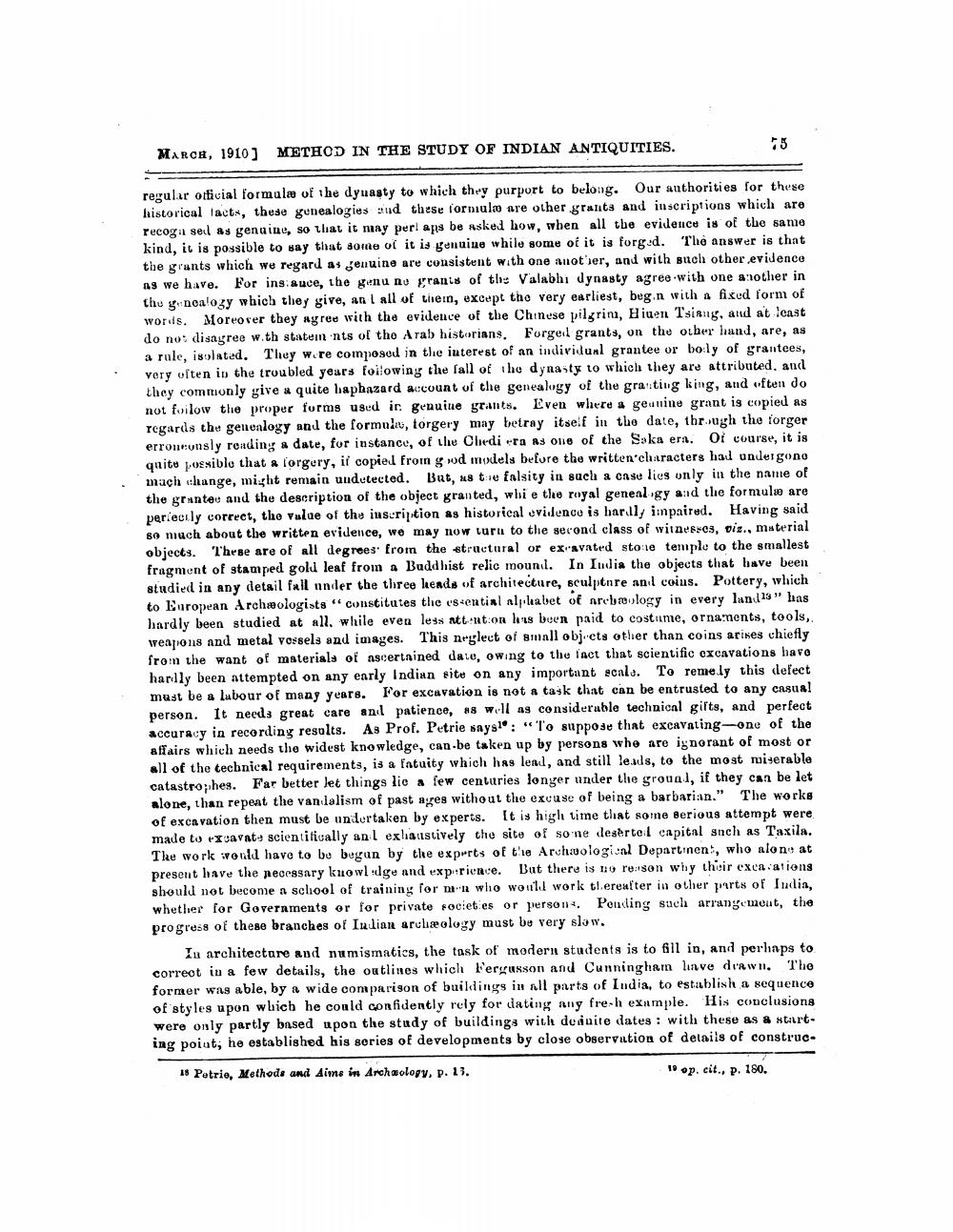________________
MARCA, 1910) METHOD IN THE STUDY OF INDIAN ANTIQUITIES.
regular official formula of the dyuasty to which they purport to belong. Our authorities for these historical lacts, these genealogies and these forniulo are other grants and inscriptions which are recogi sell as gengine, so that it may perl aps be asked how, when all the evidence is of the same kind, it is possible to say that some of it is genuine while some of it is forgd. The answer is that the grants which we regard as genuine are consistent with one another, and with such other evidence ns we have. For insauce, the genu no granis of the Valabhi dynasty agree with one another in thu genealogy which they give, an I all of them, except the very earliest, begin with a fixed form of words. Moreover they agree with the evidence of the Chinese pilgrin, Hiuen Tsiang, and at least do no: disagree w.th statem nts of the Arab historians. Forgeil grants, on the other hand, are, as a rule, isolated. They w.re composed in the interest of an individual grantee or boly of grantees, very often in the troubled years foilowing the fall of the dynasty to which they are attributed, and they commonly give a quite baphazard account of the genealogy of the granting king, and often do not foilow the proper forms used ir. genuine grants. Even where a geunine grant is copied as regards the genealogy and the formules, torgery may betray itself in the date, through the forger erroneonsly readiny a date, for instance, of the Chedi era as one of the Saka era. Oi course, it is quite possiblo that a forgery, ii copied from good models before the written'characters had undergono mach change, might remain uudetected. But, as te falsity in such a case lies only in the name of the grantee and the description of the object granted, whi e the royal geneal.gy and the formulæ are per ectly correct, the value of the inscription as historical evidence is hardl; impaired. Having said so much about the written evidence, we may now turn to the second class of witnesses, diz., material objects. These are of all degrees from the structural or excavated stone temple to the smallest fragment of stamped gold leaf from a Buddhist relic mounl. In India the objects that have been studied in any detail fall under the three leads of architecture, sculpture and coius. Pottery, which to European Archeologists constitutes the essential alılabet of reblogy in every land13" has bardly been studied at all, while even less attention lerus been paid to costume, ornaments, tools, weapons and metal vossels and images. This neglect of small objects other than coins arises chiefly from the want of materials of ascertained date, owing to the fact that scientific excavations havo harlly been attempted on any early Indian site on any important scals. To remely this defect must be a Lubour of many years. For excavation is not a task that can be entrusted to any casual person. It needs great care anil patience, as will as considerable technical gifts, and perfect accuracy in recording resolts. As Prof. Petrie says: "To suppose that excavating-one of the affairs which needs the widest knowledge, can be taken up by persons whe are ignorant of most or all of the technical requirements, is a fatuity which has lead, and still leads, to the most miserable catastrophes. Far better let things lie a few centuries longer under the ground, if they can be let alone, than repeat the van.lalism of past ages without the excuse of being a barbarian.” The works of excavation then must be undertaken by experts. It is high time that some serious attempt were made to Excavat: scientifically anl exliaustively the site of some desèrtel capital snch as Taxila. The work would have to be bugun by the experts of the Archological Departinens, who alone at present have the necessary kaowlodge and exprience. But there is no reson why their exca.alions should not become a scliool of training for a who would work thereafter in other parts of India, whether for Governments or for private focieties or person. Pending such arrangement, the progress of these branches of Indian archaeology must be very slow.
In architecture and numismatics, the task of modern students is to fill in, and perhaps to correot in a few details, the outlines which Fergusson and Cunningham liave drawn. The former was able, by a wide comparison of buildings in all parts of India, to establish a sequence of styles upon which he could confidently rely for dating ang fresh example. His conclusions were only partly based upon the study of buildings with de suite dates : with these as a starting point; he established his series of developments by close observation of details of construc
18 Potrio, Methods and Aims in Archology, p. 13.
10 op. cit., p. 180.




